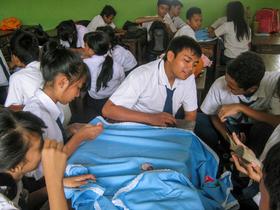Top Rankings
Burlington County Special Services School District ranks among the top 20% of public school district in New Jersey for:
Category
Attribute
Science Proficiency
Highest science proficiency (Top 10%)
Diversity
Most diverse schools (Top 1%)
Student Attention
Lowest student-teacher ratio (Top 1%)
For the 2025-26 school year, there are 2 public schools serving 455 students in Burlington County Special Services School District.
Public Schools in Burlington County Special Services School District have a diversity score of 0.70, which is less than the New Jersey public school average of 0.72.
Minority enrollment is 59% of the student body (majority Black), which is less than the New Jersey public school average of 62% (majority Hispanic).
Overview
This School District
This State (NJ)
# Schools
2 Schools
2,570 Schools
# Students
455 Students
1,360,135 Students
# Teachers
86 Teachers
116,529 Teachers
Student-Teacher Ratio
5:1
5:1
Student By Grade
District Rank
The school district's graduation rate of 40-49% has stayed relatively flat over five school years.
Math Test Scores (% Proficient)
(18-19)≤10%
44%
Reading/Language Arts Test Scores (% Proficient)
(18-19)11-19%
57%
Science Test Scores (% Proficient)
<50%
23%
Graduation Rate
(10-11)40-49%
86%
Students by Ethnicity:
Diversity Score
0.70
0.72
% American Indian
n/a
n/a
% Asian
5%
11%
% Hispanic
18%
34%
% Black
32%
14%
% White
41%
38%
% Hawaiian
n/a
n/a
% Two or more races
4%
3%
All Ethnic Groups
District Revenue and Spending
The revenue/student of $142,673 is higher than the state median of $26,940. The school district revenue/student has grown by 14% over four school years.
The school district's spending/student of $129,547 is higher than the state median of $25,837. The school district spending/student has grown by 14% over four school years.
Total Revenue
$65 MM
$36,642 MM
Spending
$59 MM
$35,142 MM
Revenue / Student
$142,673
$26,940
Spending / Student
$129,547
$25,837
Best Burlington County Special Services School District Public Schools (2025-26)
School
(Math and Reading Proficiency)
(Math and Reading Proficiency)
Location
Quick Facts
Rank: #11.
Burlington County Alternative High School
Alternative School
(Math: ≤10% | Reading: 11-19% )
Rank:
Rank:
1/
Bottom 50%10
1020 Briggs Road
Mount Holly, NJ 08060
(609) 261-5600
Mount Holly, NJ 08060
(609) 261-5600
Gr: 6-12 | 56 students Minority enrollment: 39%
Rank: n/an/a
Westampton Campus
Special Education School
20 Pioneer Blvd
Mount Holly, NJ 08060
(609) 261-5600
Mount Holly, NJ 08060
(609) 261-5600
Gr: PK-12 | 399 students Student-teacher ratio: 5:1 Minority enrollment: 61%
Frequently Asked Questions
How many schools belong to Burlington County Special Services School District?
Burlington County Special Services School District manages 2 public schools serving 455 students.
What is the racial composition of students in Burlington County Special Services School District?
41% of Burlington County Special Services School District students are White, 32% of students are Black, 18% of students are Hispanic, 5% of students are Asian, and 4% of students are Two or more races.
What is the student/teacher ratio of Burlington County Special Services School District?
Burlington County Special Services School District has a student/teacher ratio of 5:1, which is lower than the New Jersey state average of 12:1.
What is Burlington County Special Services School District's spending/student ratio?
The school district's spending/student of $129,547 is higher than the state median of $25,837. The school district spending/student has grown by 14% over four school years.
Recent Articles

School Vouchers: Updated Pros and Cons (2025 Review)
Comprehensive 2025 analysis of school vouchers, weighing benefits and challenges for families, funding, outcomes, and policy directions.

Benefits and Drawbacks of Homework in 2025
Explore updated 2025 insights on homework鈥檚 benefits, drawbacks, mental health impact, best practices, and policy trends in U.S. public schools.

Charter Schools vs Public Schools 2025: Key Differences & Trends
Explore updated 2025 insights comparing charter schools vs public schools, enrollment, academic outcomes, funding, and real-world examples for families and educators.





